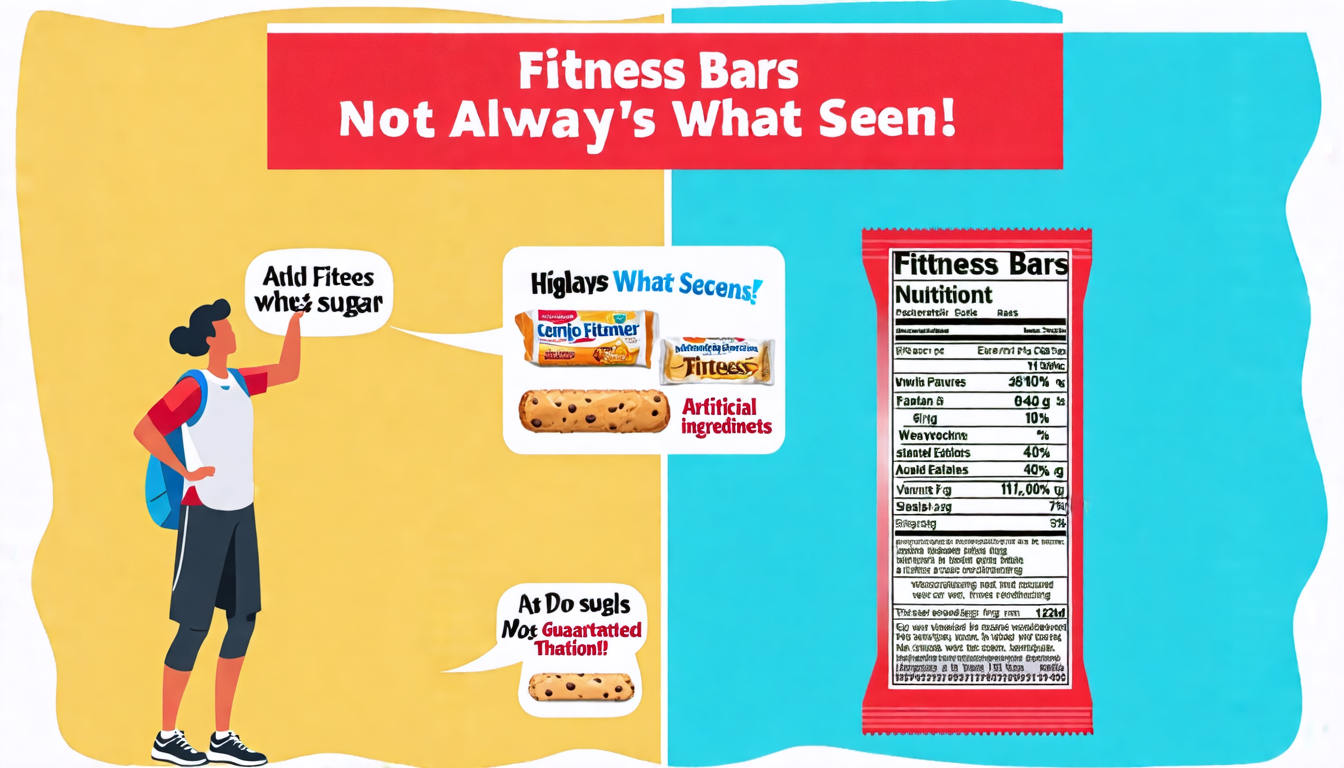In the ever-evolving world of fitness and nutrition, fitness bars have become a staple for many health enthusiasts and athletes. Yet, a cloud of misconceptions surrounds them, often leaving consumers uncertain about their true benefits and nutritional value. Are fitness bars really as healthy as they claim to be? Do they truly enhance workout performance and aid in weight management? This article aims to debunk prevalent nutritional myths about fitness bars by analyzing their actual content and comparing them to whole foods. Furthermore, we will clarify the legitimate health and performance benefits, addressing common claims and evaluating how these convenient options can fit into a balanced diet and active lifestyle. Whether you’re a seasoned athlete or just embarking on your fitness journey, understanding the facts about fitness bars is essential for making informed choices and achieving your wellness goals. Join us as we dissect the facts and fiction surrounding these popular portable snacks.
Debunking Nutritional Myths Surrounding Fitness Bars
Analyzing the Actual Nutritional Content
When it comes to fitness bars, one of the most prevalent misconceptions is that they provide an optimal balance of nutrients necessary for a healthy lifestyle. Many people believe these bars are packed with wholesome ingredients that promote muscle growth, sustain energy, and improve recovery. However, not all fitness bars are created equal, and understanding their actual nutritional content is pivotal.
Many fitness bars claim to offer high protein levels, which is a major draw for consumers looking to build muscle and sustain energy throughout the day. However, it is essential to look beyond the marketing hype and inspect the nutritional label closely. Some fitness bars can contain excessive amounts of sugar and unhealthy fats, making them less ideal for those who are health-conscious. Moreover, the protein sources can vary widely — ranging from high-quality whey protein isolates to less desirable sources such as soy protein or even collagen, which might not offer a complete amino acid profile.
Furthermore, the caloric content can also be misleading. While many bars are marketed as low-calorie options that can help in weight management, they might contain hidden calories from artificial sweeteners and fillers. These bars may boast low sugar content on the front packaging, yet include sugar alcohols like maltitol and erythritol, which can cause digestive issues for some individuals and still contribute to overall calorie intake.
Vitamins and minerals are another selling point, with some fitness bars enriched with various micronutrients. However, the bioavailability of these nutrients — the rate at which they are absorbed by the body — can be questionable. Synthetic vitamins and minerals sometimes do not offer the same health benefits as those derived from whole food sources.
Comparing Fitness Bars to Whole Foods for Protein and Energy
While fitness bars are convenient, they often fall short when compared to whole foods in terms of providing sufficient protein and energy for the body. Whole foods, such as lean meat, legumes, nuts, and dairy, offer a complete range of macronutrients and micronutrients without the need for additives or preservatives. Moreover, whole foods do not contain the fillers and artificial ingredients commonly found in fitness bars.
For muscle building and recovery, whole foods like chicken breast, eggs, and Greek yogurt offer a superior source of high-quality protein. These foods not only supply the essential amino acids required for muscle synthesis but also come with additional nutrients like vitamins B12 and D, omega-3 fatty acids, and zinc, each contributing to improved muscle function and recovery.
In terms of energy, complex carbohydrates such as those found in oats, quinoa, and sweet potatoes provide a more sustainable energy source compared to the simple sugars often found in fitness bars. These whole food options are digested more slowly, leading to a gradual release of glucose into the bloodstream, thereby avoiding the energy spikes and crashes associated with high-sugar snacks.
Moreover, whole foods are abundant in dietary fiber, an element often missing in fitness bars. Fiber aids in digestion and helps maintain a feeling of fullness, which can be key for those looking to manage their weight. While some fitness bars do include added fiber, it’s often in the form of isolated fibers like inulin, which may not offer the same benefits as naturally occurring fiber in whole foods.
Another point of comparison is the presence of antioxidants and phytonutrients. Whole foods like berries, nuts, and vegetables are rich in these protective compounds, which help fight inflammation and oxidative stress. Fitness bars, even when claiming to contain “superfoods,” may not offer these nutrients in significant amounts or their most effective form.
In summary, while fitness bars can be useful for their convenience and portability, they may not always provide the same comprehensive nutritional benefits as whole foods. Consumers aiming for a balanced diet would do well to integrate more whole food options, using fitness bars as a supplementary rather than primary nutritional source. Doing so helps ensure a diversified intake of nutrients essential for optimal health and performance.

Clarifying Health and Performance Benefits
Addressing Claims of Enhanced Workout Performance
Fitness enthusiasts often believe that consuming fitness bars can significantly enhance their workout performance. While it is true that these bars can provide a quick source of energy, it’s essential to understand the context and limitations of their benefits. Fitness bars typically contain a mix of carbohydrates, proteins, and fats, which are crucial macronutrients needed during physical activities. However, the extent to which they improve performance varies based on an individual’s overall diet, the timing of consumption, and the type of exercise performed.
Carbohydrates in fitness bars can provide a rapid energy boost, crucial for endurance sports. For example, consuming a fitness bar before a long run or an intense gym session can help maintain blood glucose levels, which can delay fatigue. Nevertheless, it’s important to choose bars with complex carbohydrates rather than high sugar content to avoid a quick spike and subsequent crash in energy levels.
Proteins in fitness bars play a pivotal role in muscle repair and growth. Eating a fitness bar rich in protein post-exercise can aid in muscle recovery. However, it’s important not to solely rely on these bars for protein intake. A balanced diet that includes whole food sources of protein such as lean meats, beans, and dairy products is essential for optimal muscle function and overall health.
Lastly, the fats in fitness bars can be a source of sustained energy, especially for prolonged, low-intensity activities. Healthy fats, like those from nuts and seeds, found in many fitness bars, can be beneficial when consumed in moderation.
Evaluating the Impact on Weight Management and Dieting
Another common misconception about fitness bars is that they are inherently beneficial for weight management and dieting. While fitness bars can be convenient and portion-controlled snacks or meal replacements, their impact on weight management largely depends on their specific nutritional profile and how they are incorporated into one’s overall dietary plan.
Many fitness bars are marketed as low-calorie, high-protein options, which can theoretically aid in weight loss by promoting satiety and preserving muscle mass. However, it is crucial to scrutinize the ingredients list. Some bars contain added sugars, artificial sweeteners, and unhealthy fats, which can contribute to blood sugar imbalances and may undermine weight loss efforts.
When selecting a fitness bar for weight management, it is essential to choose options that are high in fiber and protein, and low in sugars and unhealthy fats. Fiber and protein can help maintain fullness and reduce cravings, which is beneficial for those looking to manage their caloric intake effectively.
Moreover, the timing of consumption and the context of the fitness bar within one’s diet are critical factors. For individuals using fitness bars as meal replacements, ensuring that the bar provides a balanced mix of macronutrients and sufficient calories to replace a meal is essential. On the other hand, consuming fitness bars as snacks between meals can help bridge dietary gaps and prevent overeating later in the day.
In dieting, it is also important to consider the quality of other foods consumed. Relying heavily on fitness bars without a balanced intake of fruits, vegetables, whole grains, and lean proteins can lead to nutritional deficiencies. The key is to use fitness bars strategically within a well-rounded diet.
In conclusion, while fitness bars can offer certain health and performance benefits, it is vital to approach them with an informed perspective, understanding their limitations and the need for a balanced diet to achieve optimal results in both workout performance and weight management.
In conclusion, fitness bars are often surrounded by a variety of misconceptions that can mislead consumers regarding their nutritional value and health benefits. It is crucial to analyze the actual nutritional content of these bars, as many are packed with high amounts of sugar and artificial ingredients, which can offset their advertised benefits. By comparing fitness bars to whole foods, such as lean meats, nuts, and fruits, it becomes evident that whole foods typically offer a more balanced profile of protein and energy without the added sugars and preservatives.
Furthermore, while some believe that fitness bars can significantly enhance workout performance, the reality is that their impact varies widely depending on their specific ingredients and overall dietary context. Many fitness bars may provide a quick boost of energy, but they are not a substitute for a well-rounded diet rich in whole foods.
Lastly, when it comes to weight management and dieting, it is essential to approach fitness bars with a critical eye. While they can be a convenient option for those on the go, relying heavily on them may not be conducive to sustainable weight management. Instead, incorporating them wisely within a balanced diet can offer a convenient supplement to whole food sources.
By dispelling these common misconceptions, consumers can make more informed choices that align with their health and fitness goals, ultimately leading to better overall well-being.

